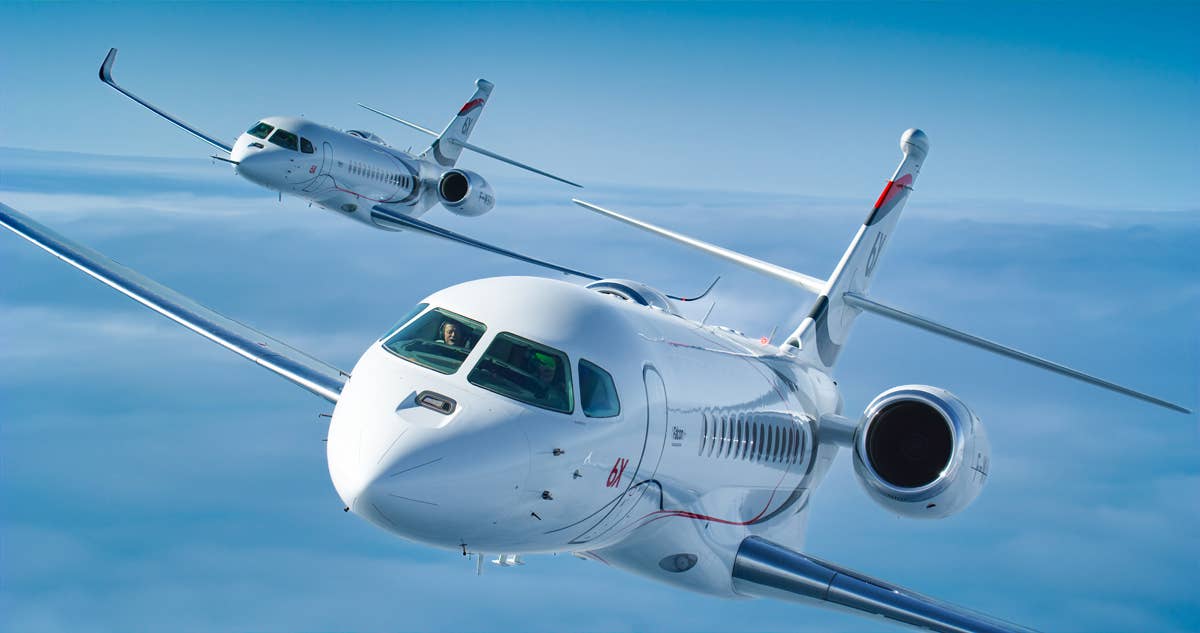Dassault Updates on 6X, 10X Programs at EBACE
A new interior option and a global ‘proving campaign’ kicks off for the Falcon 6X business jet despite headwinds from COVID’s supply chain effects.

The Dassault Falcon 6X is entering the final phase of its certification flight-test campaign. [Courtesy: Dassault Aviation]
“More people are now recognizing the benefits business aviation can bring and what it can mean to their own businesses and communities,” said Éric Trappier, chairman and CEO of Dassault Aviation, Sunday in a press conference from the National Business Aviation Association’s European Business Aviation Conference and Exhibition in Geneva, Switzerland.
EBACE gets underway on Monday at the Palexpo center at the Geneva International Airport (LSGG).
“It’s good to see the business aviation world together here in Geneva once again after three years of disruption,” said Trappier. However, headwinds from the COVID’s supply chain effects have slowed progress on the 6X.
2021 Was a Good Year
Though the world was still working through the pandemic—and continues to feel its effects—Trappier concluded that 2021 was a good year. “Flight activity climbed above pre-2019 levels and continues to grow,” he said.
Dassault witnessed the first flight of its new ultrawide-body, long-range jet, the Falcon 6X, which rose from the shelving of the 5X program that preceded it. The company also launched the Falcon 10X, an ultralong-range jet that will contest the class further in cabin width and performance.
Proving Campaign for the 6X
The 6X program has suffered as a result of supply chain disruptions reverberating around the globe. “Despite our efforts,” said Trappier, “the supply chain issues linked to the successive waves of the COVID epidemic have ended up overwhelming our engineering and production teams, thus impacting the Falcon 6X development timetable.
“Our anticipated year-end-2022 target for entry into service has shifted and is now scheduled for mid-year 2023.”
At the press conference, Trappier announced the kickoff of a “proving campaign” for the 6X, now that its initial flight-test program has concluded—including cold-soak tests, high-elevation tests, and expansion of the flight envelope beyond the projected Mach 0.90 MMO. The month-long campaign will comprise short- and long-haul segments across Europe, and to North and South America, Asia, the Middle East, and Africa, testing fully the 6X’s proposed route complex.
The tests will feature night missions, proving runs at Mach 0.88, and days packed with up to seven short hops.
The fourth 6X built is on display at Geneva, and it’s the first production model, complete with a full interior. A fifth test aircraft is under interior completion at the company’s facility in Little Rock, Arkansas, with a sixth due to arrive shortly.
“#Falcon10X is on track for Entry Into Service late 2025.” #EBACE2022 #LiveTweet pic.twitter.com/KANRftVaUU
— Dassault Falcon (@DassaultFalcon) May 22, 2022
Falcon 10X Updates
“Development of the new Falcon 10X is moving forward smoothly,” said Trappier. Parts production is now underway: “Most of the detailed design is frozen and parts, major structures, and subsystems have entered production, with final assembly of the first aircraft scheduled early next year.”
The ultralong-range “very high speed” platform is projected to fly nonstop from Geneva to Santiago, Chile, or to the west coast of Australia. The 10X remains on track for entry into service in late 2025. The company has begun construction of facilities to serve the Asia and Middle East markets with the 6X and 10X, to accommodate the new jets in Kuala Lumpur, Malaysia; and Dubai.
Dassault also revealed its latest cabin “innovation,” the Falcon Privacy Suite, which includes an individual compartment and an electrically reclining seat that converts to a lie-flat bed—befitting the ultralong-haul range of its upcoming models.
“It’s called the Falcon Privacy Suite. An individual compartment and an electrically reclining seat that converts into a lie-flat bed” pic.twitter.com/KqZ0Rx8rym
— Dassault Falcon (@DassaultFalcon) May 22, 2022
Headwinds from Environmental Concerns
Trappier also touched upon the criticality of the industry to focus effort on sustainability—to both meet its own set objectives as well as counter headwinds resulting from building government and social pressures.“Environmental concerns are continuing to trigger tax, regulatory impulses, and also the taxonomy currently being discussed within the European Commission,” said Trappier. He called out the incorporation of sustainable aviation fuel into immediate use by the business aviation community as key to staving off those pressures for the moment, and propelling the industry towards decarbonization. NBAA has led a consortium of OEMs in pledging to achieve net-zero emissions by 2050.

Subscribe to Our Newsletter
Get the latest FLYING stories delivered directly to your inbox






